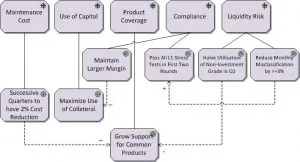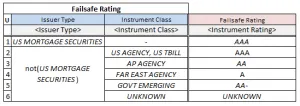Why Every Business Analyst Should Be Able to Model Business Decisions
Blog: Lux Magi - Decision Management for Finance
Introduction
In this article I propose that every business analyst should be capable of identifying and modeling business decisions precisely and transparently. They should use a prescribed, standard format to describe decision-making that can be understood by other analysts with minimal explanation, rather than the individualistic, ad-hoc spreadsheets, text documents or technical business rules that they so often use today. Business analysts should be as proficient in modelling decision as they are with data or process and decision modeling should be a recognized as a ‘tool of the trade’. Being able to precisely represent business data, process and decisions should be seen as essential to the analyst role.
Without this skill, vital business knowledge will be buried in the volumes of incoherent verbiage that constitutes most written specifications; lost in the heads of SMEs who ultimately leave the company; or obscured in millions of lines of programming code or equally obscure excel spreadsheets where it may safely hide without fear of discovery.
What are Decisions? Why are they Important?
Let me clarify what I mean by business decision. I’m not referring to strategic decisions made by CEOs in company boardrooms, but to operational decisions that are frequently automated in corporate software. An operational decision is a determination, made repeatedly by an organization during its business operations, that: has business value; requires expertise to make; must be made consistently, transparently and potentially at high volume; and may need ‘after-the-fact’ justification. Examples of this include: determining what products to offer a client visiting your company’s website, based on their previous behaviour; deciding whether to accept an insurance claim or loan application; calculating the state benefits to which a citizen is entitled and the taxes they must pay.
More importantly business decisions are distinct from business rules because they focus first and foremost on the top-down analysis of business goals and the dependencies between them, making them well suited to agile approaches. Business rules, on the other hand, tend to focus on bottom-up implementation detail and are much more fine grain and devoid of business context.
Decisions are a vital corporate asset. Their quality contributes to the profitability, client reputation and competitiveness of the organization making them. Many will control pivotal business processes and dictate how well the company performs and how it is perceived by clients. Decisions can also be an obligation: companies may have their decisions audited or have to demonstrate that they comply with externally-defined regulations. Competitive and regulatory pressures mean decisions must be regularly challenged and improved; consequently, they should be widely understood and peer reviewed. For these reasons, decisions need to be explicitly captured and managed. Companies that avoid this investment do so at their peril.
How Decision Modeling Assists a BA with Their Responsibilities
Like business data and process, business analysts must take a role in the capture, definition and evolution of their client’s decisions. Decision modelling assists BAs with many of their core responsibilities (as defined by IIBA BABOK).
Understand Clients’ Business Current State Capability
Decision modelling can be used to capture business know-how that is hidden in legacy systems before they are decommissioned or in the minds of SMEs before they leave the company. It is also a critical part of an intellectual property ‘stock take’. Modelling also externalizes the operational decisions from business processes and systems, allowing these decisions to be managed and evolved independently.
Define and Monitor Stakeholder Objectives
Decision modelling can be used to associate measurable business objectives and rationale with operational decision-making.

When used within a decision management framework, a business can monitor the ongoing effectiveness of decisions against these objectives using simple key performance indicators or analytics and feedback the results to continuously improve decision making. As new ways of making decisions are innovated they can be directly compared with the effectiveness of existing approaches.
Identify Needs, Issues and Opportunities
Decision modelling is a proven means of uncovering logical flaws within operational decision logic and identifying inconsistencies in the application of this logic at different parts of a business process long before implementation. It facilitates

early and frequent review of decision-making by business SMEs. Furthermore it rapidly identifies the data and business knowledge required for decision making, helping to highlight data availability, quality and timeliness issues early in a project lifecycle. Decision modelling also helps to analyze the boundary conditions of operational behaviour so it can be used to identify new business opportunities based on business cases previously considered outside the remit of an organization.
Analyze Strengths and Needs
The analysis of organizational structures, business processes, products and regulations; and the determination of the gap between where an organization is versus where it should be are core business analyst responsibilities. Decision modelling helps by allowing analysts to: separate business process from decisions (simplifying both), manage complexity by separation of concerns and directly associate decisions with the regulatory mandates they must satisfy. In addition, the rigorous approach and structure of decision modelling hones analysis technique.
Decision modelling’s ability to frame the use of analytics, optimizations and cognitive reasoning within a decision making helps business analysts to use past and predicted performance, constraint processing and AI as a means of informing current operational practices.
Identify and Evaluate Options
Because decision models are executable, business analysts can use them to experiment with alternative approaches to decision making without any up-front architectural commitment or infrastructure investment. They can also plan the advancement of the organization’s automation boundary by using decision modelling to locate the best cost savings, risk reduction and volume opportunities.
Design and Describe Solutions
Decision models are precise, unambiguous and transparent representations of company policy which in turn realize stakeholder needs. They can also represent a company’s interpretation of regulatory standards to which they must comply.
Indeed, decision models are so precise they are executable, meaning they can be used to demonstrate behaviour and even form the basis of a production system—in this respect decision models don’t represent ‘paper’ requirements that become shelfware, quickly overtaken by innovations in production systems— they are a live embodiment of current business policy. Transparency allows decisions to be more widely understood (by business and IT) and challenged where necessary.
Support Change Management
The explicit statement of dependencies that decision models provide allows a thorough understanding of how decisions rely on one another and underlying data. This helps with impact analysis when change is required. Similarly, the strong traceability between decision models and externally imposed regulations can be used to direct ‘keyhole surgery’ on systems when compliance mandates are updated.
Facilitate Collaboration
One of the most important aspects of a business analyst’s duty is to facilitate collaboration through effective communication and the use of industry standards assists this. Many industries benefit from the use of specific notations to collaborate, e.g., navigation charts, circuit diagrams, data models and Gantt charts. Decision modelling is no different. The use of a standard facilitates communication, encourages review and prevents mistakes. The Decision Model and Notation (DMN) is a new standard for decision modeling ratified by the Object Management Group (OMG), an international, not-for-profit, technology standards consortium specializing in the development and custodianship of standard notations used by businesses in over twenty market verticals (including standards already used by analysts like BPMN and UML).
DMN is a business oriented means of representing decisions that is: precise, supportive of analysis, executable, traceable to external mandates (e.g., regulatory specifications), measurable (against objectives) and scalable. It provides a framework that teams across an organization can use, a common language between business analysts, architects, business owners, IT professionals and analytic teams. The use of DMN improves business engagement in the management of decision making and ensures the tangible representation of business know-how outlives the production systems and brains of SMEs in which they can become mired.
Conclusion
Decision Modeling allows business analysts to represent concepts beyond business processes, data and rationale to crisply express elements of business policy that interact with all of these. They allow analysts to express what decisions are made, how they are made, what data they depend on and what external documents influence or constrain the decision. They facilitate impact analysis to determine how proposed changes to any of these affect others. They promote stakeholder understanding and manage complexity by separating concerns. They frame the use of analytics in business decision-making. In short they are a vital tool in the armory of any business analyst.